A Spanish sir who conveys peace and hope
Wednesday, January 27, 2016
Last night, I watched, on television, a very interesting interview to Vicente del Bosque (National Football Coach, in Spain), because he has just published a book entitled: "Ganar y perder. La fortaleza emocional" ("Winning and losing. Emotional strength").
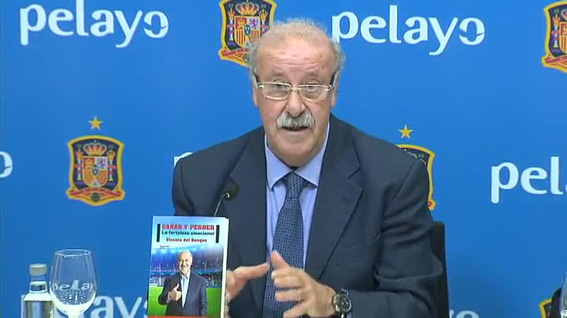
Vicente del Bosque

Below the picture,over the red colour, you can read: The effort and humility, keys to success in sport and in life.
But, after the interview, I was reading a news website and I read the sad news of the death of Colin Vearncombe (Known as BLACK, a British singer, who popularized the song "Wonderful Life" after being fired, from his former record company, in 1985).I felt a great pity, when I read the news, because I loved that song, since I was young. And also because he was very young, when he has died.
Therefore, I want to pay a little homage to Colin and send my deepest condolences to his family.
Colin will surely think, now in heaven: "I am now living my real wonderful life" . And paraphraseing a part of this song, No need to laugh and cry, because everything is perfect, there in Heaven.
If you want to remember his song, please click on the link below:
https://www.youtube.com/watch?v=e6pFdM4Whm0
Rest in peace, Colin !.
Well, but now I am going to talk you about the interview to Vicente del Bosque.
Vicente has published that book, because he wanted to convey that "the effort and humility are keys to success, in sport and in life". If you read this book, you will learn how to walk through life, because it has little bit theory and much practice. For example, Vicente says in it: “You must educate in defeat”, because he has found that, when a match or a Championship is lost, you win emotional strength; emotional balance is gained, to know how to lose, that is not easy.
Vincente also speaks of the difference between "Defeat and failure" and says that "defeat" is something athletic, you can compete and win or lose; but an athlete never fails, because someone has to lose. And as an example, a few days ago, he was, in the draw for the European Championship in Paris, and they were 24 Selectors, on stage, and Vicente was thinking inside: "23 Selectors from here they will fail"; but this is not true, they do not fail, they only lose and only win one of the 24.
Vicente also says, in the book, that, when the Selection loses a match or fit a goal, he feels a warm inside, that he can not control. The interviewer tells him: "But only inside, because outside nobody notice anything ...”. And he answered: “I like that, between victory and defeat, not much will be noted ... that, if I go out in a press conference, the journalists, who begin to ask, if someone has not watched the game, I would like that it did not know if we won or lost, because, when you win, you seem ironic, very sarcastic; and, when you lose, you usually blame the referees. Sometimes, I do not get it, but I would like to maintain that cautious tone”.
Del Bosque insists that he prefers to be quiet, but on the bench, more than standing on the sidelines, because an assistant can advise him.
In addition, he says that if you are nervous, upset, you can not make good decisions, because you are not concentrated on the game plan.
Vicente has also helped, along with the Foundation "Juegaterapia" and thanks to the money raised, with anonymous SMS, sent by many people, to build gardens, in hospitals, for sick children. The first one, which was built, was in the "Hospital La Paz", in Madrid. The second was in the "Hospital 12 de Octubre", also in Madrid. And soon, it shall be built one in the "Hospital La Fe", in Valencia.
If you want to watch how the technician built the park, in the Hospiatal La Paz, please click below:
https://www.youtube.com/watch?v=-XWOfwewboo
At the beginning of the video, a child exclaim: “Start the works…!!!!!”
And a lady answered: “Very well…., let us see, let us see it…Look at the labourers….!!!”
…………………..music…………………………………………………………………………………………..
……………………………………………………………………………………………………………………………..
Another child: “Thanks for the garden of the Hospi”
And then, you can read: And now…..For the garden of the Hospital 12 de Octubre.
And another child is talking about his dream about playing in the garden; but I do not understand what he says at the beginning of his sentences. This is what I understood: “An amusement park, my doctor from the 12 de Octubre, with a child who is sick ..... This afternoon, as I will behave very well and I will play with all the children and then I will play with other children”
Well, I hope that you have liked this last news, about the gardens in hospitals; but also, of course, about the Vicente del Bosque´s book.
Until my next post, kind regards,
Luis.
Sponsored by Costaluz Lawyers.
Please click below:

 0
Like
Published at 9:53 PM Comments (0)
0
Like
Published at 9:53 PM Comments (0)
Spanish scientists discover a mechanism to prevent memory loss in Alzheimer's
Monday, January 25, 2016
A team of researchers from the Centre for Scientific Research (CSIC) has discovered a mechanism to prevent memory loss in Alzheimer's disease, through a study of mouse models which can be consulted about possible avenues for therapeutic intervention.
The study, published in the latest issue of the journal Nature Neurosciencie, has been directed by the doctor of the Basque Foundation for Science Ikerbasque, Shira Knafo, of the Biophysics Unit, part of the CSIC and the University of the Basque Country (UPV / EHU ); Jose Antonio Esteban, from the Centre for Molecular Biology Severo Ochoa (CSIC-Universidad Autonoma de Madrid); and Cesar Venero, from the National University of Distance Education.
As reported, in a press release, Ikerbasque and the UPV / EHU, these researchers have developed a tool, to get that mice, sick of Alzheimer, retain memory.
As explained by these entities and CSIC, in a separate statement, the neurons communicate with each other, using synaptic connections, in which the exchange of information, from one neuron to another, is given and are not static, but are modulated, each to other, due to the activity or experience of neurons.
This phenomenon is known as synaptic plasticity, which is a fundamental mechanism of learning and memory. Alterations, in synaptic plasticity, cause difficulties in memory formation, which occurs in Alzheimer's.

These researchers have found that, in this disease, the synaptic plasticity is altered by a protein, originally described as a tumor s research group of the Dr. Stebuppressor, called PTEN, which is what hinders memory.
In 2010, the team of research, from the Centre of Molecular Biology Severo Ochoa, discovered that this protein is present, at synapses, and participates in physiological modulation, during synaptic plasticity.
The work, now published, evidences that this mechanism gets out of control, in Alzheimer's disease, hampering memory, when sending one of the pathological agents of the disease, the beta-amyloid, the PTEN protein into synapses excessively.
Researchers have developed a molecular tool that blocks the arrival of PTEN synapses, with which have achieved that neurons are resistant to the beta-amyloid and Alzheimer's patients mice retain memory.
According to the same sources, it is a basic science research, with animal models, but it contributes to dissect the mechanisms, that control cognitive functions and provides guidance on possible avenues for therapeutic intervention, for mental illness, in which these mechanisms are defective.
Well, I hope that you have considered interesting this news.
Until my next post, kind regards,
Luis.
Sponsored by Costaluz Lawyers.
Please click below:

 0
Like
Published at 9:42 AM Comments (3)
0
Like
Published at 9:42 AM Comments (3)
A spanish recipe with rice
Thursday, January 21, 2016
We all know that rice is a cereal, considered a staple food in many culinary cultures, as well as in some parts of Latin America. Rice is the second cereal, most produced worldwide, after the corn.
We also know that there are several recipes, with rice, for example: sushi casero, rice with sausage (chorizo), rice with rabbit, American rice and, for essert, rice pudding. But, today, I want to show you a very simple recipe: Rice with mushrooms, because each serving provides a good dose of energy, to face the rest of the day, besides important nutrients like vitamidns, minerals and fiber.
These are the Ingredients (for 4 persons): Rice - 300 grams. Onion - 1 unit. Cloves garlic - 2 units. Mushrooms - 250 grams. Carrot - 100 grams. Rice - 300 grams. Onion - 1 unit. Cloves garlic - 2 units. Mushrooms - 250 grams. Carrot - 100 grams. Peas - 120 grams. Tomato sauce - 90 grams. Olive oil - 3 tablespoons. Vegetable broth - 1 liter. Salt to taste. Black pepper - to taste Peas - 120 grams. Tomato sauce - 90 grams. Olive oil - 3 tablespoons. Vegetable broth - 1 litre. Salt to taste. Black pepper - to taste.
And now, I am going to explain you the development of the dish, in 12 easy steps:
- First, we peel the garlic and chop finely.
- We cut the onion in half, we remove the skin and chop each half finely.
- With the aid of a peeler, we remove the skin of the carrots and cut them into small pieces.
- We pour the vegetable broth, in a saucepan and put it to heat.
- We heat olive oil, in a frying pan, and add the three ingredients, that we have just processed. We cast a pinch of salt. We cook, over medium heat, stirring regularly, until they are soft.
- Meanwhile, we clean the mushrooms, with a damp cloth. It is important to do so, because, if we wash them under running water, they will absorb a lot of water, which would make them lose flavor and aroma.
- Once we have clean them, we cut them into sheets of a thickness of between 2 and 3 millimeters.
- When the vegetables, that we have in the saucepan, are tender, we add the mushrooms. We continue to cook, until they lose some of their water and soften.
- Then, we pour the fried tomato, the rice and the ground pepper. We mix well.
- We pour the vegetable broth and stir. We cook, over medium heat, maintaining a moderate boil, until the rice is tender.
- After 10 minutes of cooking, we incorporate the peas and mix, to be distributed evenly. We continue cooking.
- When the rice is just right, we remove the saucepan, from heat, and serve.
An advise: Cooking time depends on the type of rice used, if it is a usual white rice, it is ready in 15-20 minutes. If you use an integrated rice, you must cook 30 to 40 minutes.
And this must be the result of the recipe:
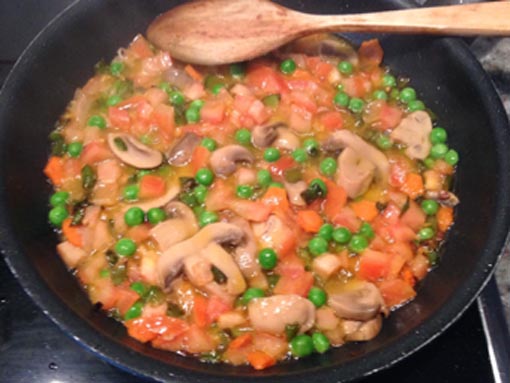
Rice with mushrooms
Well, I hope that you have liked this recipe and tou ffel like to try it.
Until my next post, kind regards,
Luis.
Sponsored by Costaluz Lawyers.
Please click below:

 1
Like
Published at 10:57 AM Comments (0)
1
Like
Published at 10:57 AM Comments (0)
A botanical garden in a wonderful mountains of Southern Spain
Tuesday, January 19, 2016
The Botanical Garden, “El Castillejo”, is located within the Sierra de Grazalema Natural Park, Biogeográphic Sector from Ronda, which stretches from the Sierra de Grazalema to the Sierra de Loja --comprising all the Mountain range of Ronda, Sierra de las Nieves and Sierra Bermeja--, and characterized by basic soils.
It is one of the botanical gardens of the network, that manages the Board of Andalusia.
Its primary goals are to preserve the plant species from Cadiz, endangered, threatened and endemic species, as well as promoting awareness, by public in general, of human use of the plant environment.
Within its facilities, there is a visitor center, where you implement educational plans, focused on conservation of the flora, the recovery of endangered species and research. Numerous schools and associations frequently visit it, to attend these training activities.
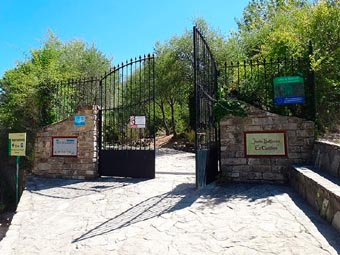
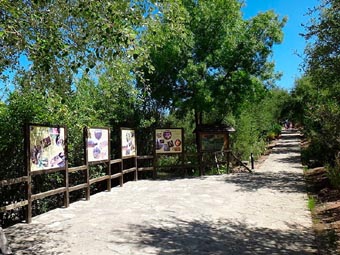
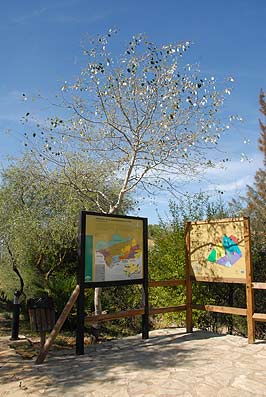
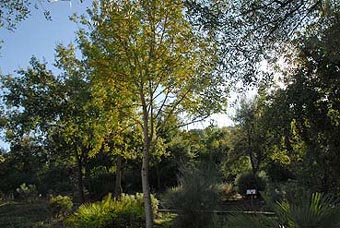
“El Castillejo” Botanical Garden is located in the village of El Bosque (Cádiz). It can be accessed from Cadiz by Jerez de la Frontera and Arcos de la Frontera (A-372), from Málaga by Ronda and Grazalema (A-372) and from Seville (N-IV) by Villamartín (A-371) and Prado del Rey (A-373). It is situated on the outskirts of the village, at its northern end. It is accessed by the stone pavement road, that goes from the fish farm or from the road between El Bosque to Benamahoma (Km. 31), where we find a path, on the left side of the road. Both access have signaling.
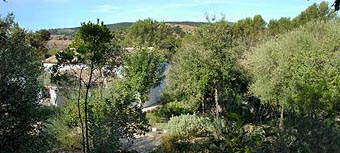
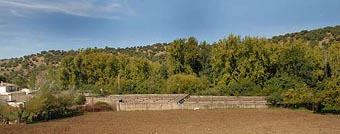
Throughout the visit, we find specimens of the most representative plant species of the main ecosystems of the Sierra de Grazalema Natural Park.
Among the ecosystems represented, we can find the Acebuchal --which forms woodlands, along with other species such as mastic trees, wild roses and myrtles--. It has a high ecological value, as a refuge and feeding ground for numerous birds. Among its uses, highlight the lop and consumption of fruit (the acebuchina) by cattle, firewood and charcoal.
There is also a land full of cork oaks, which is Nestled on acidic soils (low abundance in the Sector of Ronda), move from these enclaves to the holm oak, when the humidity increases. The undergrowth is formed by numerous species, such as myrtle (Myrtus communis) and madrone (Arbutus unedo), olivilla (Phillyrea angustifolia) and ruscos (Ruscus hypophyllum). Alcornocal (land full of cork oaks) degradation results heaths, in wet areas, and thickets, in dry areas
You can find a Grassland, which are stages replacement of holm-oaks wood and thermomediterranean (bioclimatic ground, that you can find in any are of the Mediterranean climate) gall-oaks grove, dry sub-humid ombroclimate to wet, transformed into crops or grazing areas, in low altitudes, up to 900 metres. The representative species would be holm oaks (Quercus rotundifolia), gall oaks (Quercus faginea), wild olive trees (Olea europaea var. Sylvestris) and dispersed carob trees(Ceratonia siliqua), with shrubs as Pistacia (mastic), Phlomis lychnitis (phlox), Phlomis purpurea (matagallo), Daphne gnidium (Torvizco) and Chamaerops humilis (Palmetto), jérguenes (Calicotome villosa), crazy brooms (osyris alba), flammula Clematis, Clematis vitalba and asparagus (Asparagus acutifolius)

There is also a holm-oak wood, which is the most representative plant formation and which occupies biger extent, with dominion of the oak (Quercus rotundifolia), on limestone substrate, in the mesomediterranean ground. The companion species would be barberries (Rhamnus alaternus), broom (Retama sphaerocarpa), peonies (Paeonia coriacea) and honeysuckle (Lonicera implexa) their total adaptation to the characteristics of the Mediterranean climate and its plasticity even allow it to take places with minimum ground like streams and stony slopes. The montanera, or feeding pigs, with acorn, has been until recently, along with production of coal, the main use of oak.
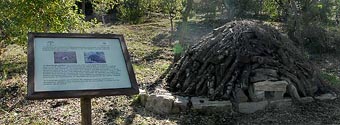
The gall-oaks (Quercus faginea) are in the most humid and warm places (valleys and river beds), where they are mixed with holm-oaks or simply move them. They are ash trees, that are accompanied by shrubs, also deciduous, like Crataegus monogyna (Hawthorn, hawthorn) and wild roses (Rosa sempervirens).
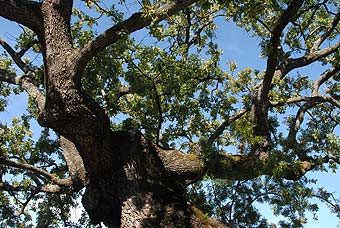
In the rivers of permanent flow, a typical vegetation, called "riberbank forest", is developed: Fraxinus angustifolia (Fresno), Salix eleagnos subsp angustifolia, Ulmus minor (Olmo) and Populus alba (white poplar), Populus nigra (black poplar). They follow the course of streams, because they could not live far from them. Joining them, blackberries (Rubus ulmifolius), rosebush (Rosa canina, Rosa sempervirens), Dorycnium rectum (Unciana) compose a tangle, that becomes the creek in a real green tunnel.
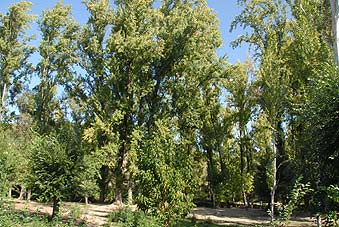
In non-permanent courses and lower courses, are developed oleanders (Nerium oleander) and tamarisks (Tamarix africana), respectively.
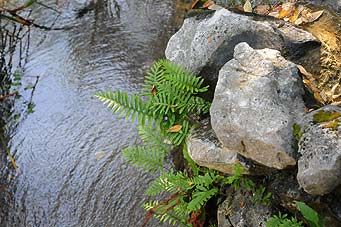
In the Natural Park of El Bosque, you can also find a rupicola vegetation, that grows on the tops of the mountains, rocky slopes and rock crevices has a number of very interesting adaptations, aimed at responding to excessive solar radiation, to the scarcity of land and wind. The rounded, padded, very close to the ground and whitish are dominant. They form the juniper Juniperus communis subsp hemisphaerica, Juniperus Sabina (Sabina creeping), Erinacea anthyllis (Piorno blue), Ononis reuteri, Hormathophylla spinosa (Rascaculos) and Bupleurum spinosum.
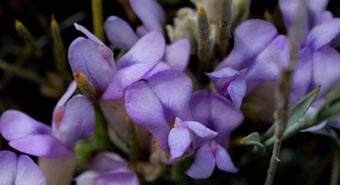
Blue piorno
In the peaks, formed by dolomites, the rupícolas communities are developed, which are interesting, from a botanical point of view, because there are a large number of endemic, rare and endangered flora, as the opium poppy from Grazalema (Papaver rupifragum), African Rupicapnos subsp decipens, Putoria calabrica, Biscutella frutescens, Silene andryalifolia, Saxifraga globulifera or Centaurea clementei.
The most abundant tree is the Abies pinsapo (Spanish fir) and only develop in certain enclaves across the sector as Sierra de Grazalema, Sierra de las Nieves and Sierra Bermeja. During the ice ages, it must have occupied larger areas, but rising temperatures has relegated it to the freshest and shady places of the highest mountains.
The pinsapo is endangered and, therefore, protected by law. The vegetation, that accompanies the pinsapo, is not very abundant: it is mixed with gall, Helleborus foetidus (Ballestera grass), male daphne (Daphne laureola), ivy (Hedera helix), lilies (foetidissima Iris, Iris planifolia orchid and Cephalantera rubra), Blonde pilgrim, blackthorn (Prunus spinosa) and gorse (Ulex baeticus).
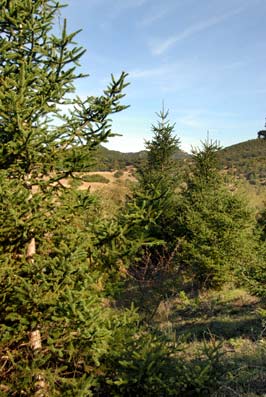
Spanish fir

Leaves of Pinsapo (spanish fir)
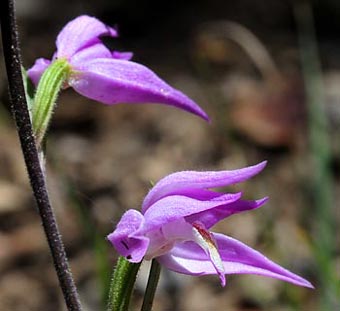
In the south of the province of Malaga, appear outcrops of metamorphic volcanic rocks, called peridotites. Its degradation leads to coils, that cause not only a poor soil, but is toxic, due to the high concentration of heavy metals. An interesting group of species has adapted to live in these extreme conditions.
But there is also a group of endemic species, such as: Echinospartum algibicum, Erodium recoderi, Papaver rupifragum and Allium Rouyi.
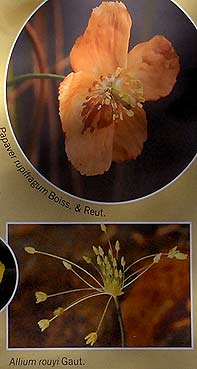
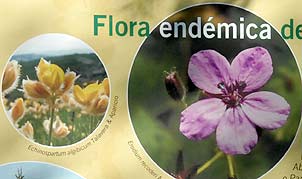
This is another part of the Botanical Garden:
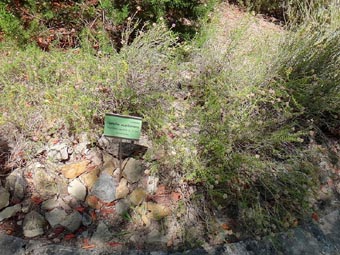
Well, I hope that you want to visit this Natural Park. In that case, I am going to tell you that “El Castillejo” Botanical Garden opens its doors, to the public, from Tuesday to Sunday, from 10 to 16 h, from October to April.
During the summer season, from May to September, the hours are from 10 to 14 h (in the morning) and 18 to 20 h. (evening). Admission is free.
The Botanical Garden is situated in:
Avenue “El Castillejo”, without number.
11670 – El Bosque (Cádiz)
Well, until my next post, kind regards,
Luis.
Sponsored by Costaluz Lawyers.
Please click below:

 0
Like
Published at 11:08 AM Comments (1)
0
Like
Published at 11:08 AM Comments (1)
Spanish Flamenco Art around a piano
Wednesday, January 13, 2016
The last Saturday, I could find an interview to a Spanish pianist and composer, on the radio. I could watched the interview, because there were two cameras of tv inside the studio of the programme.
This pianist was in the programme in order to present his last cd (“Paseo a dos” = “Walk two”). Then, he was talking about his youth –when he started to play guitar, at home--; but, he also played the piano several times. I did not know him, but I loved his way of playing; I think that it is a wonder.
His name is David Peña Dorantes; but I think that he is known as Dorantes. And he is a Flamenco pianist. Dorantes reminds me of another Spanish pianist –concretely from Cadiz--, named Manolo Campuzano.
At the beginning of the interview, David said that his last cd was born when he met his friend (the bass player, Renaud García-Fons). They were playing together about ten years; but sometimes and when they met, they thought several ideas to compose a piece of music. They met at David´s home, in the village of Sevilla, Mairena del Aljarafe.
A very important David´s trait is his improvisation. He use a lot his creativity. For example, David explained the tittle of his last cd, remembering that, when he was locked, with Arnaud, at David´s home, to record this album, during one week, as they were too tired, they nneded to go out home for a walk, to clear their minds.
In the album, we can find several “palos” (bats, types of music) of Flamenco: Soleás, Guajiras, Malagueñas .... because for David, they are the starting point to get to know other concepts. David knows that Renaud has a different training --even David has a classic formation--; but they leave from Flamenco Bats.
But, in 2012, David published his third album: “Sin muros” (“Without walls”).Through this album, David wanted to reflect that grace, that he lived when he was a child, by his father (the guitarist Pedro Peña), his uncle (Juan "El Lebrijano") and other ones --singing and dancing, in several gypsy parties (“always elegant parties”,as David said), at David´s grandmother´s home--.
I can show you a video of the tittle: “Without walls either padlocks”, from the album “Without walls”, with Arnaud García-Fons. If you want to watch this video, please click below:
https://www.youtube.com/watch?v=2mfP_0-ndFY
David, before playing the piano, began playing guitar and accompanied singers of Flamenco as Esperanza Fernandez, Enrique Morente and Carmen Linares.
David studied piano in the Conservatory of Seville; but he says that for him the real Conservatory was his grandmother´s home, because, in that, house, there was a piano, which it played, with two fingers, when he was 4 years old. A little bit later, his grandfather bought a pianola and David went mad with happiness….Since that moment, he decided to dedicate playing piano himself.
I knew the piece “Orobroy” (which means ”Pensamiento”=”Thought”, in gypsy language.He published this piece in 1999.), because I heard it through the radio; but I did not know its composer. Now I love that music and I should like to share it with you. If you want to watch a video with that piece, played by David Dorantes, and accompanied by a chorus of girls, with Pilar Bogado (the girl with a bandana), for example, please click below:
https://www.youtube.com/watch?v=jepdKmVekWc
And there is another version, that I like very much, because I find a lot of art in it. If you want to watch the video of this other version, please click below:
https://www.youtube.com/watch?v=5VDu6uPdIxY
Dancer: Laura Pirri.
Well, I hope that you have enjoyed this music, such as I did.
Until my next post, kind regards,
Luis.
Sponsored by Costaluz Lawyers.
Please click below:

 0
Like
Published at 11:48 AM Comments (0)
0
Like
Published at 11:48 AM Comments (0)
The impressive fall of a river in the eastern Spain
Monday, January 11, 2016
Near the village of Albacete, Riópar, is one of the most spectacular natural wonders of Spain, the source of the river Mundo (World). This river, which the locals call Reventón (puncture), has its source in a karst cave, filled to overflowing and precipitates vacuum. Riópar, also it has a wide network of houses, that will serve you to rest a few days, in the middle of nature.
Although this river is called World, it does not refer to the substantive World, but the adjective "world" (opposite of "unclean"), ie clean, washed, clear).
Well, but yesterday I could watch on tv a report about the river Mundo and I thought that it was an impressive place, which I should like to show you, in case you do not know it. Then, if you want to watch the video, please click below:
http://www.antena3.com/videos-online/viajestic/renventon-rio-mundo_2016010800802.html
Alba Dueñas (The presenter of the report): “Water, vegetation and limestone welcome us to one of the seven wonders of Spain.The river rural Mundo travels around 130 kilometres and its flow varies according to the season, the proof is the 60 liters per second, that it took last Summer, and has come to reach 70,000 liters per second, last Spring ............. Federico: We are just where the Mundo is born”
Federico Ballesta: ”Yes, we have all the evidences, here, of that is true ...; we are in a karst amphitheatre, a sack-shaped valley, which is only open on the north face, which is where the river World escapes, to go in the direction of the Segura (river) and the Mediterranean Sea”
Note: The Mundo is the main tributary of the Segura.
While Federico was speaking, you could read the following: Federico Ballesta. He guides us through the Calar of the river Mundo. It is a sack-shaped valley. Only open on the north face.
Alba: “When the river Mundo multiplies its flow per thousand, the locals you give a special name”
Federico: “We call it the Reventón, by the noise, which is produced, dropping all that amount of water, from 84 meters .... We know exactly ... ,or almost exactly, when it shall occur, because a pluviometer, that we have here up the Calar, tells us that, when they fall 200 or 220 liters per square meter, within a week, is when the Cave is loading and the Reventón occurs”
Note: Reventón is similar than “blowout” in a wheel of a car.
Calar refers to this: The Natural Park of the Calares of the river Mundo is a protected natural area located to the southwest of the province of Albacete.There are several Calares and another names, and one of them is the Calar of the river Mundo.
While Federico was speaking, you could read, on the image: The peak flow lasts 24 hours.
Rain and snow are filtered. They go to the Cueva de los Chorros (Cave of the Streams).
Federico: “All that water comes from up here, where we are right now, in this Calar, they are rainwater, that are filtering .., they are collected by the sinkholes, the poljes, the simas..and it goes out through the collector, through the main drainage, which is the Cueva de los Chorros, under us, 1222 metres high.... Its dimensions are 21 metres wide by 15 high .... Everything has been done primarily by the dissolution of water, by a limestone, which is highly fractured, it is very porous .., water has ability to go opening holes”.
Note: While Federico was speaking, you could read the following: Water and snow are filtered.
Alba Dueñas (in off): “And, from the limestone of the river Mundo, to the limestone of Riópar Viejo”
Note: The river Mundo is born among the villages Vianos and Riópar (Albacete, Eastern Spain).
While the presenter was speaking, you could read: We move about Riópar Viejo.
Alba: “A charming village, with narrow streets, where the silence surprises us ... because, Miguel, you are between the few, who live during all the year, in the village”
Miguel Raneau (Rural houses “El Arranca”): “That is right, effectively. My wife and I live all year, because this village was abandoned, in the year 96, when Samuel died, and then there was a group of people and .... we personally made houses, as second houses and as rural tourism”.
Note: While Miguel was speaking, you could read: The village was uninhabited and was dedicated to rural tourism”
Miguel: “This is one of our houses and, as you can see, the decor is modern, in a rustic atmosphere ... Its facilities include: a spacious kitchen, a bathroom with hydromassage; we have a courtyard-garden, with barbecue, for people to enjoy and is, there, at fresh air, with its family and friends, because our motto is that people feel themselves like at home”
Well, I hope that you have liked the video and also you can go to that area.
Until my next post, kind regards,
Luis.
Sponsored by Costaluz Lawyers.
Please click below:

 0
Like
Published at 11:07 AM Comments (0)
0
Like
Published at 11:07 AM Comments (0)
The Cat Soup in the southern Spain
Friday, January 8, 2016
On day 6, the Three Kings brought me several books with recipes and, one of those books have a recipe, that has a funny tittle: “Sopa de gato de Cádiz” ("Cat soup from Cadiz"), in the south western Spain. So I would like to show you the recipe for this dish. It is a very simple soup.
These are the Ingredients (for four persons): 400 grams of stale bread. 4 cloves of garlic. Oil and salt.
First, you have to cut the bread into thin slices and put them, in a clay pot.
Now, you take the garlic, peel and fry them whole, in a pan, plenty of oil. Then, put water and salt –but, be careful, because it can splash--.
When the broth of the Cat soup starts to boil, pour the liquid over the bread, which should be very soggy. Try it, if it is to your liking. Then, take it to the oven, with the hot grill, in order to grill it, for about five minutes. So, we have a Cat soup from Cadiz, with mild garlic flavor.
And this one must be the result:
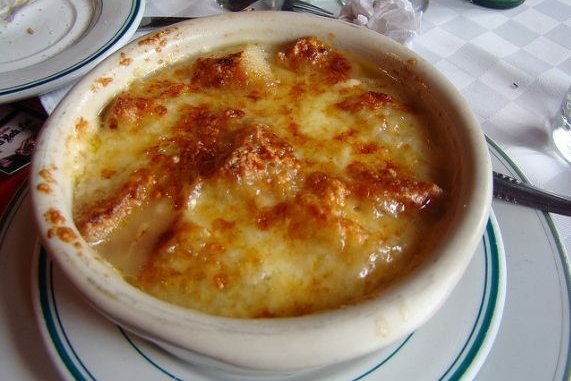
Well, I hope that you have liked the recipe and you can try to cook it.
Until my next post, kind regards,
Luis.
Sponsored by Costaluz Lawyers.
Please click below:

 0
Like
Published at 11:28 AM Comments (0)
0
Like
Published at 11:28 AM Comments (0)
A team of Spanish scientists made gluten-free foods
Tuesday, January 5, 2016
Yesterday, in the morning, I was listening the radio and the presenter of the programme interviewed two scientists, from the University of Cartagena, who talked about food related to the Celiac disease.
Researchers from the Department of Food Engineering of the Polytechnic University of Cartagena (UPCT) have won two patents, that lower the cost of industrial production of pre-cooked meals gluten-free. The research was based on the croquettes and pasta dishes: cannelloni, lasagna, spaghetti and macaroni.
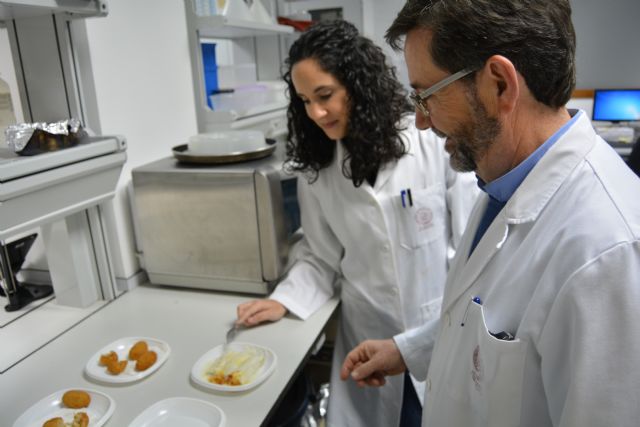
The Professor Antonio López and the Agronomist Sonia Soto tasting some cannelloni
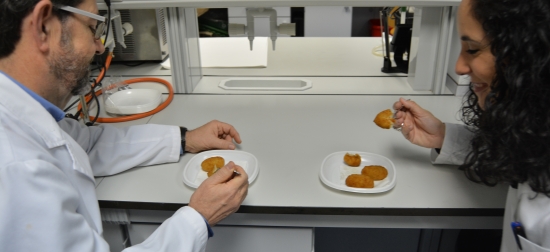
Antonio López and Sonia Soto tasting croquettes
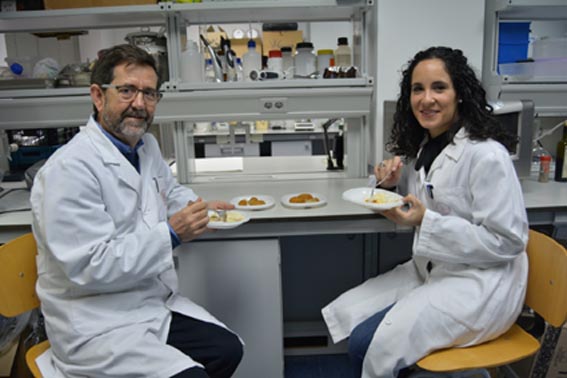
Antonio Lopez and Sonia Soto eating cannelloni
Today, the dishes prepared gluten-free cost the double that conventional ones and their quality is improvable. "One of the challenges of the food industry is to reduce their costs and improve their taste and nutritional quality, to reach growing number of consumers", said Antonio López, responsible researcher.
One of the advantages of the new manufacturing technique of croquettes gluten-free is absorbing half of oil than conventional ones, when fried; "so, they are softer and healthier, they are not too heavy and you want to keep eating", says Antonio Lopez. Another advantage is the quality and taste, which greatly improves over croquettes gluten-free, that are currently on market. So, they are appealing for any type of consumer, whether or not celiac.
The researchers, at the School of Agronomists, have achieved an adequate texture, in the dough of croquettes, to handle it industrially. "The gluten gives strength and consistency to the mass of croquettes, providing a good viscoelasticity, when wheat flour is used. During its industrial production, dumplings are formed and they fall, at high speed, and if they have not the right texture, they remain flat, as cookies", López added. Therefore, researchers have had to replace the wheat flour of the white sauce by rice flour and other components, that achieve a similar texture to the dough. The breadcrumbs of these croquettes are also gluten-free and developed specifically for a breading of adequate quality.
The research group has made possible the industrial management of dough of pasta gluten-free in sheets.
"The manufacturers made large sheets, which can exceed 15 metres long and 50 centimetres wide and just over 1 millimeter thick and, if the mass does not include gluten, they break themselves", Lopez explains. This causes the gluten-free pasta in sheets are currently manufactured, almost by hand, so the prices of the relevant prepared dishes are very high. With the new technique of industrial production of gluten-free pasta in sheets can reduce costs considerably.
Making croquettes and pasta gluten-free is focused on frozen ready meals sector, but also can be refrigerated.
The patents, called "Composition and method of making breaded foods with low oil absorption during frying" and "Composition and procedure for industrial processing of gluten-free pasta in sheets", have been generated in the doctoral thesis, defended by Sonia Soto Jover, agronomist and Master of Advanced Techniques in Research and Agricultural Development and Food, qualified with full marks (cum laude). Part of the conclusions of the thesis were published in two prestigious international journals on Technology and Food Engineering: “Food Engineering Reviews” and “LWT - Food Science and Technology”.
They explained, in the interview, they were researching from 2010 to 2014.Then, from 2014 to 2015, they were preparing the patents. And now, from 2015, they are searching a company, which is able to take these products to market.
The research was led by the Professor, Antonio Lopez Gomez, and have collaborated the teachers Arturo Esnoz and Asuncion Iguaz, and the researchers Sonia Soto and María Boluda.
Gluten is found in wheat, barley and rye, three foods that are grown from about 10,000 years ago. In the last decade, the number of people to avoid this protein complex, present in cereals, is on the rise. Approximately between 1 and 5% of the population suffers the celiac disease. Therefore, increasingly, the major manufacturers of food are changing their recipes, to attend to this demand.
Well, I hope that they find a company, as soon as possible, to help many people with this disease.
Until my next post, kind regards,
Luis.
Sponsored by Costaluz Lawyers.
Please click below:

 0
Like
Published at 11:29 PM Comments (0)
0
Like
Published at 11:29 PM Comments (0)
The Garganta del Capitan in southern Spain
Monday, January 4, 2016
Algeciras (Cádiz, Southern Spain) has a route, that surprises with its beautiful waterfalls and being inspiration for a captivating fantasy literature.
Supposed hidden treasures and ghosts accompany the spectacle of a place, that is easily accessible for its good signage.
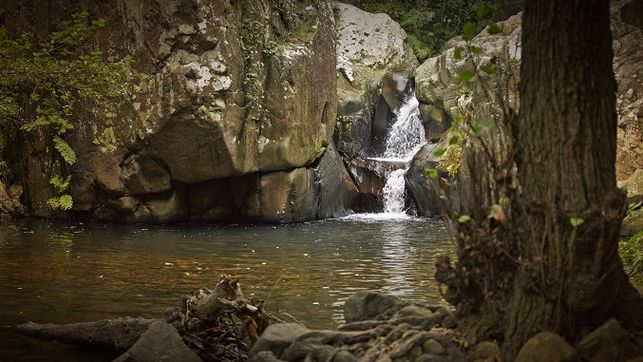
"Garganta del Capitán" ("Captain´s throat")
Anyone who sees the typical online photo of the Waterfalls Captain's Throat, without knowing what it is, it will think that it is a location of the next filming of The Lord of the Rings, in New Zealand, or in some remote corner in the antipodes. And it is in Algeciras, within a route, that can be done within a medium difficulty, and for which you only need to feel like walking and lungs to breathe clean air.
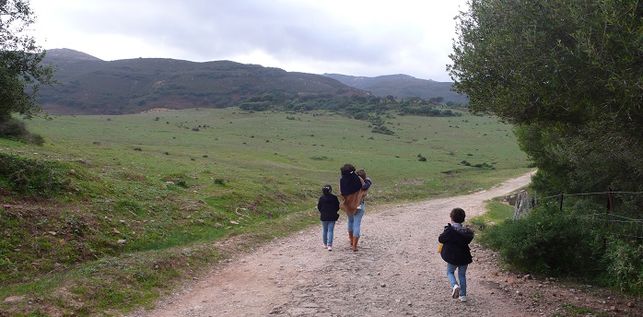
The route to the Captain´s thoat
The tour begins in what is known as the Green Gate of Algeciras. A big gate leads into the hill Matapuercos, where is easy to find grazing cows and pigs living with walkers and visitors to the area. The stream of the Fuente Santa is the appetizer of what we will find later, in the area of the joint (canuto), which is a type of forest gallery, that takes place in the margins of freshwater courses.
There are several alternatives, presented by the route; but the most attractive and livable is to visit the ruined mills that follow. The first look is that of San Jose, who at the time was paper mill and flour later. It is nice to make a stop, along the way and flip through a building, that invites you to imagine what could happen there, half a century ago.
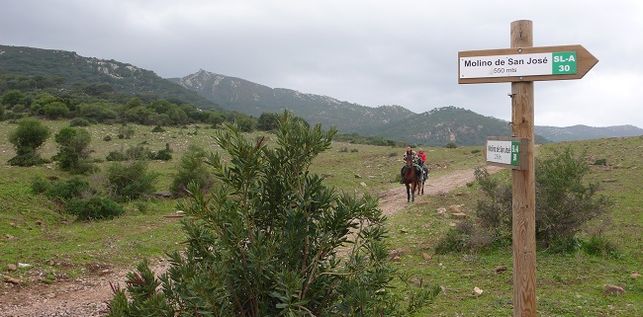
The route to the San José Mill
A thick vegetation accompanies hikers, along a path parallel to the river. The second mill to appear is that of Enmedio and then reaches the mill of Caves, with mysterious aspect because of being hidden, between the vegetation. History books tell that became as nine water mills which used the nearby waters.
Following upriver appear ferns, in a striking amount, welcoming a region plagued by ponds, where they are already printed more features of this route. The mere sound of water is already relaxing, although visitors must wait out the rainy season, for these pools show the usual idyllic appearance.
In the Captain's Throat is his grave. Legend tells that Gabriel Moreno, a soldier who fought in the war of Denmark, returned to Spain as captain and, after taking part against the Napoleonic invasion, remained in the area of Algeciras, as a smuggler. He was shot and buried in a mass grave. Legend tells that its spirit appeared and a priest sent carve a stone cross, on the stone, where they said they saw it. Moreover, it is said that, just in the Captain's Throat there is a hidden treasure. More literature, for hikers, lovers of fantastic.
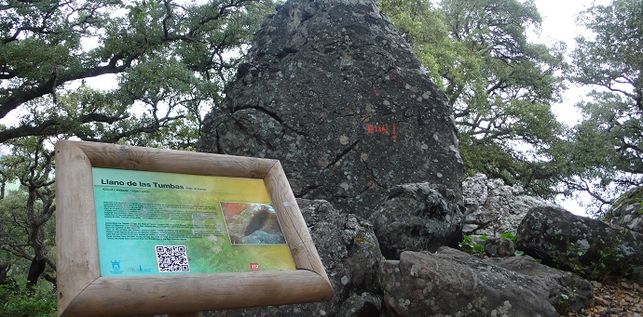
The flat of the tombs, in the Captain´s throat
This circumstance is irrelevant, because the main thing in this route is not pursuing ghosts, but to discover a place, that is out of the ordinary. The flat of the tombs also offers an unusual image, in nature: a meadow with little grove, where there are remains of anthropomorphic tombs. In general, the trails are well marked and it paves the way for non-locals, who are surprised to find a place with so much substance environmental level and also in the historical. And, even at the level of the paranormal, to be a mine in paragraph legends and fables.
Well, I hope that you have liked to know something about these places and also that you can come here to know them personally.
Until my next post, kind regards,
Luis.
Sponsored by Costaluz Lawyers.
Please click below:

 0
Like
Published at 12:38 PM Comments (0)
0
Like
Published at 12:38 PM Comments (0)
Open your eyes in Spain
Friday, January 1, 2016
Last night, I watched, on television, a very nice commercial. At the beginning, I thought that it was a trailer, because it looked like a Spanish film; but, at the end, I saw it was an advert of the company Campofrio (food company: cooked ham, etc).
I loved this advert, because it spoke of a very human and very positive feelings, such as: the hope --which should not be missed ever--. And above all, it made a bet, very firm, in favour of LIFE.
Pay attention, at the end of the advert, because you can watch the main and so famous square of Chinchón (a very nice village, that I recommend you, situated 44 kilometres to the south east of Madrid).
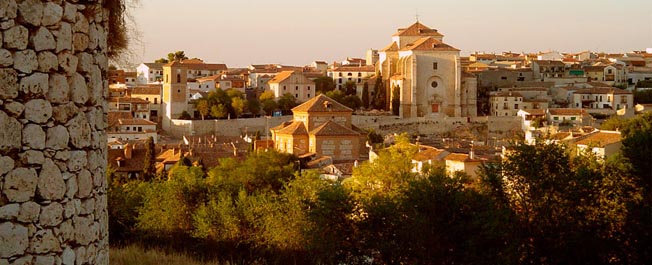
Chinchón, Madrid
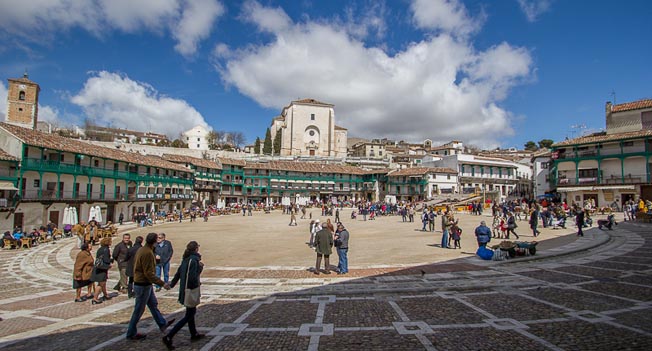
Main square in Chinhón, Madrid
If you want to watch this video, please click below:
https://www.youtube.com/watch?v=lxTzvnhm13g
The comatose patient opens his eyes.
The nurse is looking at the patient and shouts: “Doctor……Doctor…..!”
The Doctor: “It has been a long time ... it is.....it is difficult to determine what he has forgotten ...You must go slowly ..... As the world is, it can be a shock for him .... it is a bit like starting all over again”.
The patient´s wife: “This is your daughter”
….music (the song: “Volver” = “Return”)………
The patient´s wife: “You put on that….very much”
…..music…………….
The patient´s wife: “This ……….is love”
……music…………..
A patient´s friend: “Come here……., you are here……welcome….”
The patient´s wife: “This is your family”
The patient´s wife: “These are your friends”
A friend: “Squiiiiid……………What happens?!”
Another friend: “That is not your team”
The patient´s daughter: “I can not explain you this one”
The patient´s wife: “This is a hangover”
……music……………
The patient´s wife: “This……is your village”
…..music…………
The daughter: “Daaaad…..!..............Brake!!!”
….music………………
The waiter: “This……to whet your appetite”
A friend with glasses: “This is a disaster ....., soon we will not be able to go out, and say what we think or what we like to eat or breathe or anything .......... What feels like is to get in bed, close your eyes and not open them again .....”
…silence…..
A friend beside: “Are you fool….or what happens with you?”
A friend with glasses: “I….what I mean….”
The patient: “Right, right, I know what you mean…, the world has not changed much; but believe me that there are too many things, every day .... why worth opening your eyes, wake up,……. leaving to live up .... ....... ..... This………. is life”
Another friend: “The siesta has been good for you…, Eh, friend…?.....Spanish siesta… Eh?, of true ones…. Eh?”
Well, I hope that you have liked this video, such as I did. I also hope this new year brings PEACE to our world; that wars disappear; that distances among brothers, among parents and children, and among different people are shorter. And I hope that all of us are able to value everything good, that we have: health, family, friends…….
I wish you a very happy New Year 2016.
Until my next post, kind regards,
Luis.
Sponsored by Costaluz Lawyers.
Please click below:

 0
Like
Published at 4:29 PM Comments (1)
0
Like
Published at 4:29 PM Comments (1)
Spam post or Abuse? Please let us know
|
|